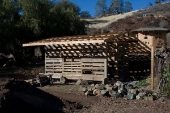posted 12 years ago
Hello Gillian,
No, cob architecture does not have to be round, and historically most weren't, and many still built today by cultures that have used cob for millenia do not. What you are seeing done today is the "new age," and "back to earth" types reinventing the cob wheel, as it were. Most of these modern cob structures are built by amateur enthusiasts, some reading a few books, and a few with a little travel and academics behind them. Most are built from "concept," not practical training in any of the traditional building arts. I don't mean for this to sound like a condemnation of any kind, just a warning. Many folks are getting wrapped up in the romance of cob and what they see so many folks doing. For those of use with traditional training, we get alarmed. I would say, conservatively, that the majority of cob structures being built today, or in the last 10 years are built and facilitated by folks with less than 5 structures under there belt, most it is there first, and they are getting guidance from some that "love cob," but no little of other traditional building modalities, including the many vernacular and traditional styles of cob.
With that said...
Most cob structures, like the one in your shared photo for example are, or have an internal superstructure of wood framing often a timber frame. I would not recommend a novice even attempt a multi store "full cob" structure. It must have an internal armature of wood framing. In general I do not recommend cob to the novice builder, it is being romanticized by too many as be "really easy" to do. In some was it can be, but in many others there are things that are not being considered or understood (too many to even try to list here.) If you are doing this yourself as a first build, read everything you can get your hands on, and look at the traditional building methods for the best guidance in structure and durability, cob or otherwise. Ask and seek as out as much advice as you can. Yes curved walls are stronger if building "full cob" structures, but no stronger than "full cob" done traditionally with ramparts or other applicable traditional reinforcements.
Good Luck





![Filename: TradCobDevonWeb.jpg
Description: Old English cob house, not curved [Thumbnail for TradCobDevonWeb.jpg]](/t/29796/a/12628/TradCobDevonWeb.jpg)








 or two.
or two.




 2
2


















